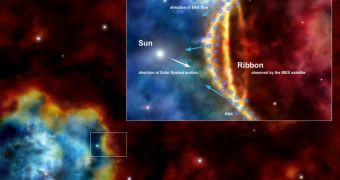Astronomers announce that they've recently discovered a worrying fact – our Sun, and with it the entire solar system, including Earth – is heading for contact with a massive, hot cloud of interstellar gas. The meet-up will take place within the next 100 years or so, and the event will represent the cosmic-scale equivalent of global warming. The extent of the damage that this collision will have on our planet has not yet been calculated, but astronomers believe that Earth should suffer little to no negative side-effects. But astronauts going to space will be exposed to increased amounts of radiation, they add.
The first signs that something was heading towards the Sun (or vice-versa) were recorded by the Voyager 1 and 2 spacecrafts, which are currently en-route to exit the solar system. The robotic probes looked at the solar wind, the stream of charged particles that permeate the space between the planets, and determined that the envelope it creates is uneven in one direction. This is the direction in which the Sun is moving, which can only mean that something is pushing against this layer, causing it to deform. Finding out precisely what the root cause of this phenomenon is has been a long-standing goal for researchers, and it would appear that a valid explanation has finally been set forth.
The termination shock asymmetry that the Voyagers discovered is produced some 14 to 15 billion years away from the Sun, where solar wind particles bump into counterparts from the interstellar space. The result is a massive surge in radiation, which is unevenly distributed. A hot cloud of interstellar gas may help explain this occurrence, astrophysicists say. This answer was first suggested by the two probes, but it wasn't until the NASA Interstellar Boundary Explorer (IBEX) spacecraft was launched two years ago that physicists got the confirmation they needed. But the satellite also uncovered a mystery of its own, when he detected the existence of a “ribbon”-like structure at the edge of the solar system, made up of charged particles.
Though it initially surprised everyone, the ribbon eventually led to the development of the new theory, which is based on both Voyager and IBEX data. Scientists now believe that the ribbon's existence can be explained by the fact that the Sun is heading towards an ancient supernova remnant. Interactions between the two may account for the asymmetries taking place at the edges of the solar system. Details of the explanation appear in the latest issue of the esteemed Astrophysical Journal, ScienceNow reports.

 14 DAY TRIAL //
14 DAY TRIAL //